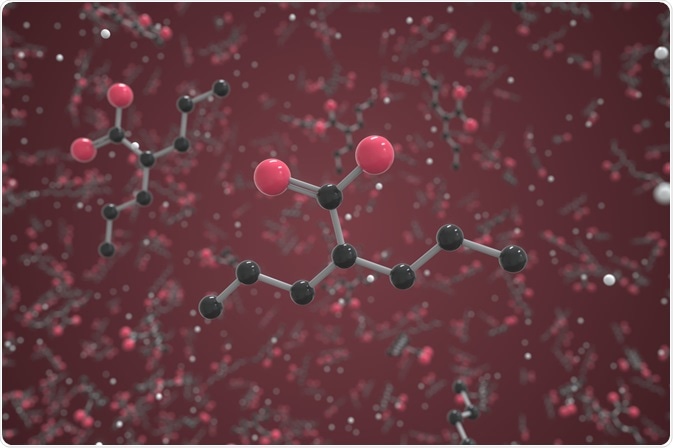Valproic acid dissociates to form valproate ions in the body, which has numerous effects on the neuronal tissue in the brain. This accounts for its broad clinical activity and uses in several different types of seizure types and other health conditions.
For this reason, there is no single mechanism of action that is accepted to encompass the wide utility of this drug. Instead, it is believed that there are several neurophysiological mechanisms involved in the pharmacological action of valproate, explaining why its use can be beneficial for various types of seizures that are characterized by unique molecular events.

3d rendering of a valproic acid molecule. Image Credit: Irina Anosova / Shutterstock
Increase Gamma-aminobutyric Acid (GABA)
Gamma-aminobutyric acid (GABA) is an important neurotransmitter that is widely accepted to play a significant role in the specific region of the brain related to the generation and propagation of seizures.
It is believed that valproic acid has an effect on the production of GABA, which leads to increased levels of the neurotransmitter in the brain and, consequently, serves to prevent the occurrence of seizures. In addition to this, valproate is also thought to enhance the effect of GABA that already exists in the area on the receptors. Alternatively, medical research has also suggested that valproate mimics the action of GABA, thus decreasing the risk of having a seizure.
Valproate has been suggested to mediate the neuronal excitation of N-methyl-D-aspartate (NMDA) glutamate receptors, which is also likely to contribute to its anticonvulsant effect.
Inhibition of Sodium and Calcium Channels
Voltage-gated sodium and calcium channels are also thought to play a pivotal role in the way valproic acid works. Although the exact method has not been clearly established, observation studies have suggested that these channels in the brain are likely to have an impact on the prevalence of some seizure types, particularly absence seizures.
Further study is required in this area to determine how valproate affects the functionality of sodium and calcium channels, and the subsequent effect on epileptic seizures.
Pharmacokinetics
The pharmacokinetics of valproic acid is important to understand how it is utilized in the body and the extent of the effect it can exert.
The pharmaceutically active component of the medication is absorbed well into the bloodstream with a bioavailability of 81-89%. This means the majority of the drug is absorbed, which happens on a relatively quick timeframe with the peak plasma concentration for standard release medications at approximately 2 hours after administration. For this reason, sodium valproate is also available as an extended release formulation to allow for a more gradual absorption and more convenient dosing once per day. Valproic acid is highly bound to protein in the blood, which accounts for its volume of distribution value of 92L.
Approximately 30-50% of the original active ingredient is excreted in the urine, and the remaining majority is first metabolized. The liver plays an essential role in the metabolism of valproic acid, with the involvement of the CYP2C9 enzyme in this process. 2-propyl-3-ketopentanoic acid is a metabolite that may result from valproic acid undergoing reactions in the liver. Overall, the clearance of the drug ranges from 7 – 16 hours, depending on the age and individual characteristics of the patient.
References
Further Reading
Last Updated: Dec 22, 2022